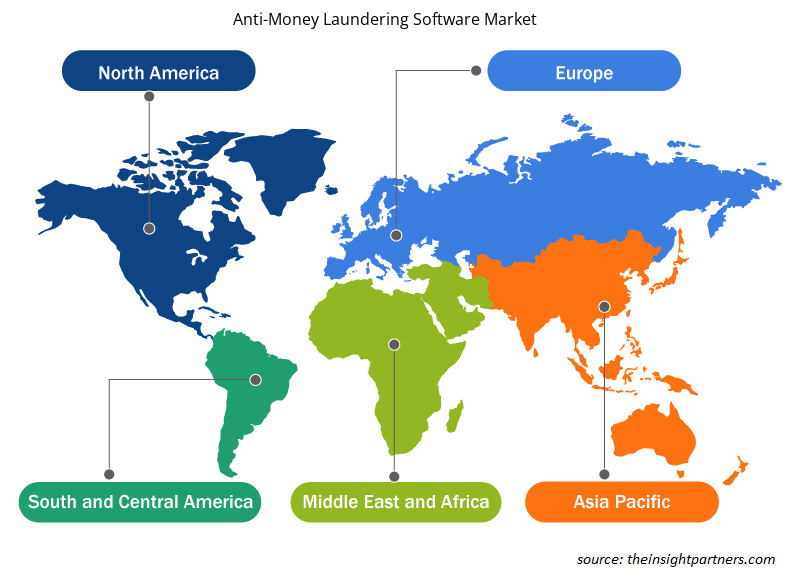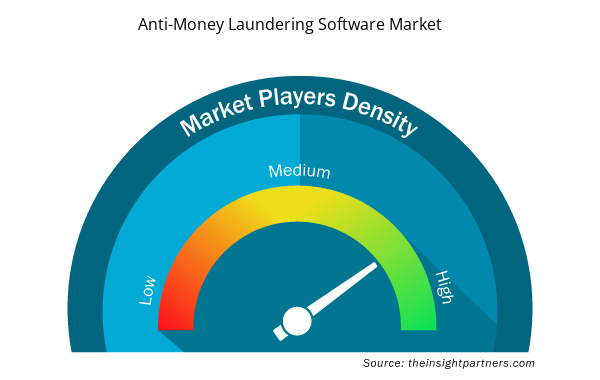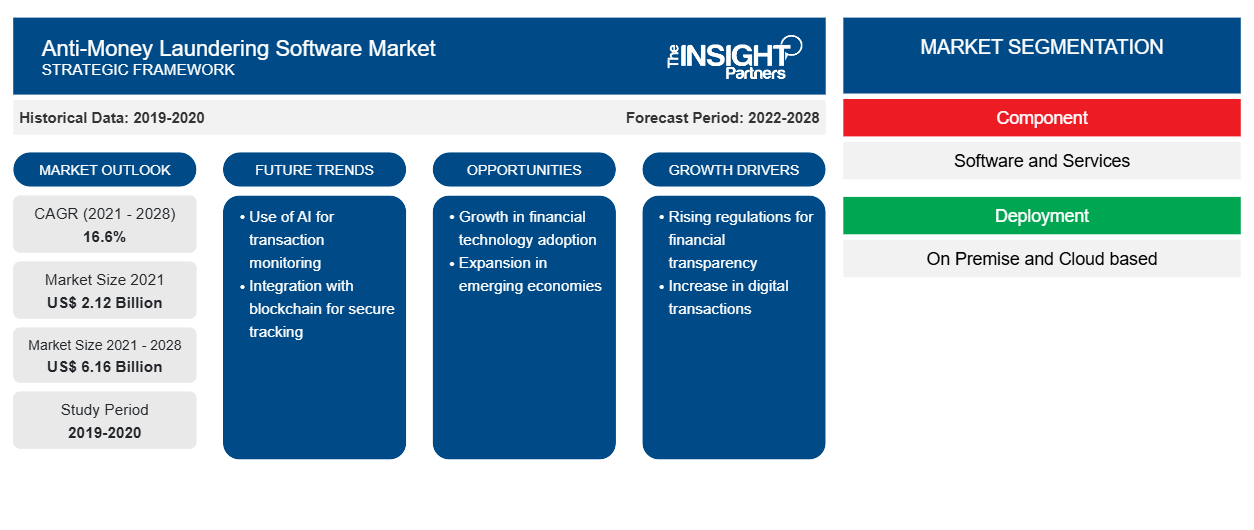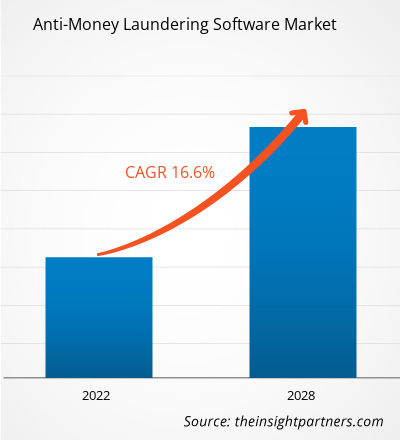[Informe de investigación] Se espera que el tamaño del mercado de software contra el lavado de dinero crezca de US$ 2.116,3 millones en 2021 a US$ 6.162,8 millones en 2028; Se estima que el tamaño del mercado de software contra el lavado de dinero crecerá a una CAGR del 16,6% entre 2022 y 2028.
Los avances tecnológicos están disparando el número de ciberdelincuentes . Sin embargo, las empresas FinTech tienen el potencial de ayudar a los bancos de todo el mundo a mantenerse competitivos en el mercado global. El uso de sistemas más robustos combinados con tecnologías avanzadas en el seguimiento de la moneda digital , el aprendizaje automático y la conexión de datos han abierto posibilidades para combatir el lavado de dinero. Con la creciente adopción por parte de los consumidores y los consiguientes volúmenes de transacciones en las empresas FinTech competitivas en 2019, muchas empresas cambiaron a prácticas automatizadas contra el lavado de dinero. Los sistemas automatizados contra el lavado de dinero proporcionan un número insignificante de falsos positivos en comparación con los generados por los datos y la tecnología tradicionales. Esto reduce los efectos adversos de los falsos positivos, manteniendo los costos operativos dentro del rango esperado.
Considerando la creciente conexión entre FinTech y las soluciones AML , en diciembre de 2020, la Asociación de Especialistas Certificados en Antilavado de Dinero anunció el lanzamiento de un nuevo programa de certificación para las empresas FinTech que buscan cumplir con los estándares regulatorios. La asociación también desarrolló el programa Certified AML FinTech Compliance Associate en colaboración con FINTRAIL . El programa está diseñado para aumentar el conjunto de herramientas de cumplimiento del personal de FinTech que trabaja en la prevención de delitos financieros en el nivel de entrada. Por lo tanto, el enfoque creciente de FinTech en la implementación de soluciones AML está impulsando el crecimiento del mercado de software contra el lavado de dinero .
Los clientes no tienen control sobre la ubicación de la infraestructura; esto infiere que si el centro de datos de un proveedor es violado, la empresa no tendrá control sobre el período de tiempo de la interrupción o qué datos pueden concederse. Todos los clientes en nubes comparten el mismo grupo de infraestructura con protecciones de seguridad limitadas, variaciones de configuración y accesibilidad. Dejando de lado las limitaciones de control, los riesgos de seguridad y las restricciones de políticas, hay varias situaciones en las que una implementación en la nube es más adecuada. Sin embargo, las nubes son de mayor tamaño en comparación con el tipo de implementación local, debido a lo cual las empresas asociadas con la nube se benefician de una escalabilidad fluida y bajo demanda. La implementación en la nube es ideal para organizaciones que están dispuestas a adoptar soluciones de análisis con baja inversión. Principalmente permite a las empresas obtener los datos con todos sus servicios, pero con un gasto económico.
Personalice este informe según sus necesidades
Obtendrá personalización en cualquier informe, sin cargo, incluidas partes de este informe o análisis a nivel de país, paquete de datos de Excel, así como también grandes ofertas y descuentos para empresas emergentes y universidades.
- Obtenga las principales tendencias clave del mercado de este informe.Esta muestra GRATUITA incluirá análisis de datos, desde tendencias del mercado hasta estimaciones y pronósticos.
Perspectivas regionales del mercado de software contra el blanqueo de dinero
Los analistas de Insight Partners explicaron en detalle las tendencias y los factores regionales que influyen en el mercado de software contra el blanqueo de dinero durante el período de pronóstico. Esta sección también analiza los segmentos y la geografía del mercado de software contra el blanqueo de dinero en América del Norte, Europa, Asia Pacífico, Oriente Medio y África, y América del Sur y Central.

- Obtenga datos regionales específicos para el mercado de software contra el lavado de dinero
Alcance del informe sobre el mercado de software contra el blanqueo de dinero
| Atributo del informe | Detalles |
|---|---|
| Tamaño del mercado en 2021 | US$ 2.12 mil millones |
| Tamaño del mercado en 2028 | 6.160 millones de dólares estadounidenses |
| CAGR global (2021-2028) | 16,6% |
| Datos históricos | 2019-2020 |
| Período de pronóstico | 2022-2028 |
| Segmentos cubiertos | Por componente
|
| Regiones y países cubiertos | América del norte
|
| Líderes del mercado y perfiles de empresas clave |
|
Densidad de actores del mercado: comprensión de su impacto en la dinámica empresarial
El mercado de software contra el blanqueo de dinero está creciendo rápidamente, impulsado por la creciente demanda de los usuarios finales debido a factores como la evolución de las preferencias de los consumidores, los avances tecnológicos y una mayor conciencia de los beneficios del producto. A medida que aumenta la demanda, las empresas amplían sus ofertas, innovan para satisfacer las necesidades de los consumidores y aprovechan las tendencias emergentes, lo que impulsa aún más el crecimiento del mercado.
La densidad de actores del mercado se refiere a la distribución de las empresas o firmas que operan dentro de un mercado o industria en particular. Indica cuántos competidores (actores del mercado) están presentes en un espacio de mercado determinado en relación con su tamaño o valor total de mercado.
Las principales empresas que operan en el mercado de software antilavado de dinero son:
- ACENTURO
- ACI EN TODO EL MUNDO
- CONSULTORÍA TECNOLÓGICA ASCENT
- SISTEMAS BAE
- Compañía: Eastnets Holding Ltd.
Descargo de responsabilidad : Las empresas enumeradas anteriormente no están clasificadas en ningún orden particular.

- Obtenga una descripción general de los principales actores clave del mercado de software contra el lavado de dinero
- Análisis histórico (2 años), año base, pronóstico (7 años) con CAGR
- Análisis PEST y FODA
- Tamaño del mercado Valor/volumen: global, regional, nacional
- Industria y panorama competitivo
- Conjunto de datos de Excel



Report Coverage
Revenue forecast, Company Analysis, Industry landscape, Growth factors, and Trends

Segment Covered
This text is related
to segments covered.

Regional Scope
North America, Europe, Asia Pacific, Middle East & Africa, South & Central America

Country Scope
This text is related
to country scope.
Preguntas frecuentes
The Anti-money laundering software market is estimated to grow at 6162.8 million US dollars in 2028 at a CAGR of 16.6%.
The Increasing focus of FinTech on implementing automated anti-money laundering systems and Rising demand for sophisticated transaction monitoring solutions are driving the anti-money laundering software market
The Information sharing among banks and other financial institutions and Increased use of artificial intelligence are the future trends for the Anti-money laundering market.
Accenture, Open Text Corporation, Oracle, BAE Systems and SAS are the five key players holding the major market share in the Anti-money laundering software market.
North America is holding major market share of Anti-money laundering market.
Transaction Monitoring is the leading product segment in the Anti-money laundering software market.
The incremental growth of Anti-money laundering software market during the forecast period is US $ 3711.2 million.
Trends and growth analysis reports related to Technology, Media and Telecommunications : READ MORE..
The List of Companies - Anti-Money Laundering Software Market
- ACCENTURE
- ACI WORLDWIDE
- ASCENT TECHNOLOGY CONSULTING
- BAE SYSTEMS
- EASTNETS HOLDING LTD.
- OPENTEXT CORPORATION
- ORACLE CORPORATION
- NICE Ltd.
- SAS INSTITUTE
- Nasdaq Inc
The Insight Partners performs research in 4 major stages: Data Collection & Secondary Research, Primary Research, Data Analysis and Data Triangulation & Final Review.
- Data Collection and Secondary Research:
As a market research and consulting firm operating from a decade, we have published and advised several client across the globe. First step for any study will start with an assessment of currently available data and insights from existing reports. Further, historical and current market information is collected from Investor Presentations, Annual Reports, SEC Filings, etc., and other information related to company’s performance and market positioning are gathered from Paid Databases (Factiva, Hoovers, and Reuters) and various other publications available in public domain.
Several associations trade associates, technical forums, institutes, societies and organization are accessed to gain technical as well as market related insights through their publications such as research papers, blogs and press releases related to the studies are referred to get cues about the market. Further, white papers, journals, magazines, and other news articles published in last 3 years are scrutinized and analyzed to understand the current market trends.
- Primary Research:
The primarily interview analysis comprise of data obtained from industry participants interview and answers to survey questions gathered by in-house primary team.
For primary research, interviews are conducted with industry experts/CEOs/Marketing Managers/VPs/Subject Matter Experts from both demand and supply side to get a 360-degree view of the market. The primary team conducts several interviews based on the complexity of the markets to understand the various market trends and dynamics which makes research more credible and precise.
A typical research interview fulfils the following functions:
- Provides first-hand information on the market size, market trends, growth trends, competitive landscape, and outlook
- Validates and strengthens in-house secondary research findings
- Develops the analysis team’s expertise and market understanding
Primary research involves email interactions and telephone interviews for each market, category, segment, and sub-segment across geographies. The participants who typically take part in such a process include, but are not limited to:
- Industry participants: VPs, business development managers, market intelligence managers and national sales managers
- Outside experts: Valuation experts, research analysts and key opinion leaders specializing in the electronics and semiconductor industry.
Below is the breakup of our primary respondents by company, designation, and region:

Once we receive the confirmation from primary research sources or primary respondents, we finalize the base year market estimation and forecast the data as per the macroeconomic and microeconomic factors assessed during data collection.
- Data Analysis:
Once data is validated through both secondary as well as primary respondents, we finalize the market estimations by hypothesis formulation and factor analysis at regional and country level.
- Macro-Economic Factor Analysis:
We analyse macroeconomic indicators such the gross domestic product (GDP), increase in the demand for goods and services across industries, technological advancement, regional economic growth, governmental policies, the influence of COVID-19, PEST analysis, and other aspects. This analysis aids in setting benchmarks for various nations/regions and approximating market splits. Additionally, the general trend of the aforementioned components aid in determining the market's development possibilities.
- Country Level Data:
Various factors that are especially aligned to the country are taken into account to determine the market size for a certain area and country, including the presence of vendors, such as headquarters and offices, the country's GDP, demand patterns, and industry growth. To comprehend the market dynamics for the nation, a number of growth variables, inhibitors, application areas, and current market trends are researched. The aforementioned elements aid in determining the country's overall market's growth potential.
- Company Profile:
The “Table of Contents” is formulated by listing and analyzing more than 25 - 30 companies operating in the market ecosystem across geographies. However, we profile only 10 companies as a standard practice in our syndicate reports. These 10 companies comprise leading, emerging, and regional players. Nonetheless, our analysis is not restricted to the 10 listed companies, we also analyze other companies present in the market to develop a holistic view and understand the prevailing trends. The “Company Profiles” section in the report covers key facts, business description, products & services, financial information, SWOT analysis, and key developments. The financial information presented is extracted from the annual reports and official documents of the publicly listed companies. Upon collecting the information for the sections of respective companies, we verify them via various primary sources and then compile the data in respective company profiles. The company level information helps us in deriving the base number as well as in forecasting the market size.
- Developing Base Number:
Aggregation of sales statistics (2020-2022) and macro-economic factor, and other secondary and primary research insights are utilized to arrive at base number and related market shares for 2022. The data gaps are identified in this step and relevant market data is analyzed, collected from paid primary interviews or databases. On finalizing the base year market size, forecasts are developed on the basis of macro-economic, industry and market growth factors and company level analysis.
- Data Triangulation and Final Review:
The market findings and base year market size calculations are validated from supply as well as demand side. Demand side validations are based on macro-economic factor analysis and benchmarks for respective regions and countries. In case of supply side validations, revenues of major companies are estimated (in case not available) based on industry benchmark, approximate number of employees, product portfolio, and primary interviews revenues are gathered. Further revenue from target product/service segment is assessed to avoid overshooting of market statistics. In case of heavy deviations between supply and demand side values, all thes steps are repeated to achieve synchronization.
We follow an iterative model, wherein we share our research findings with Subject Matter Experts (SME’s) and Key Opinion Leaders (KOLs) until consensus view of the market is not formulated – this model negates any drastic deviation in the opinions of experts. Only validated and universally acceptable research findings are quoted in our reports.
We have important check points that we use to validate our research findings – which we call – data triangulation, where we validate the information, we generate from secondary sources with primary interviews and then we re-validate with our internal data bases and Subject matter experts. This comprehensive model enables us to deliver high quality, reliable data in shortest possible time.


 Obtenga una muestra gratuita de este informe
Obtenga una muestra gratuita de este informe